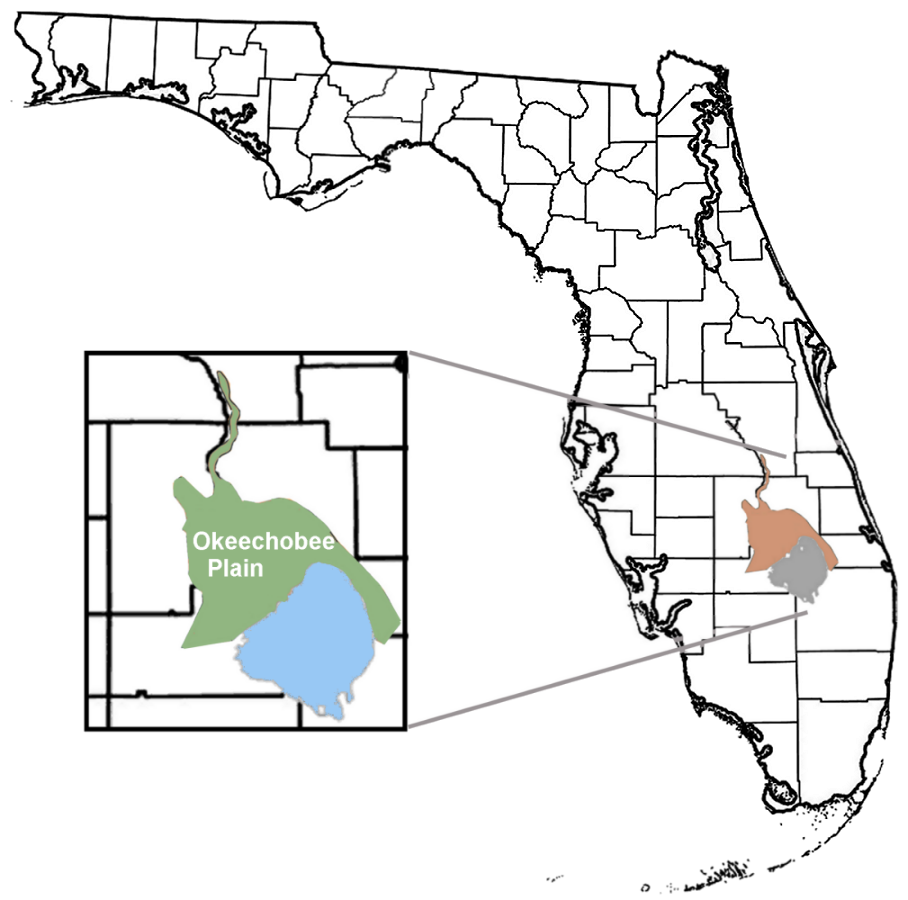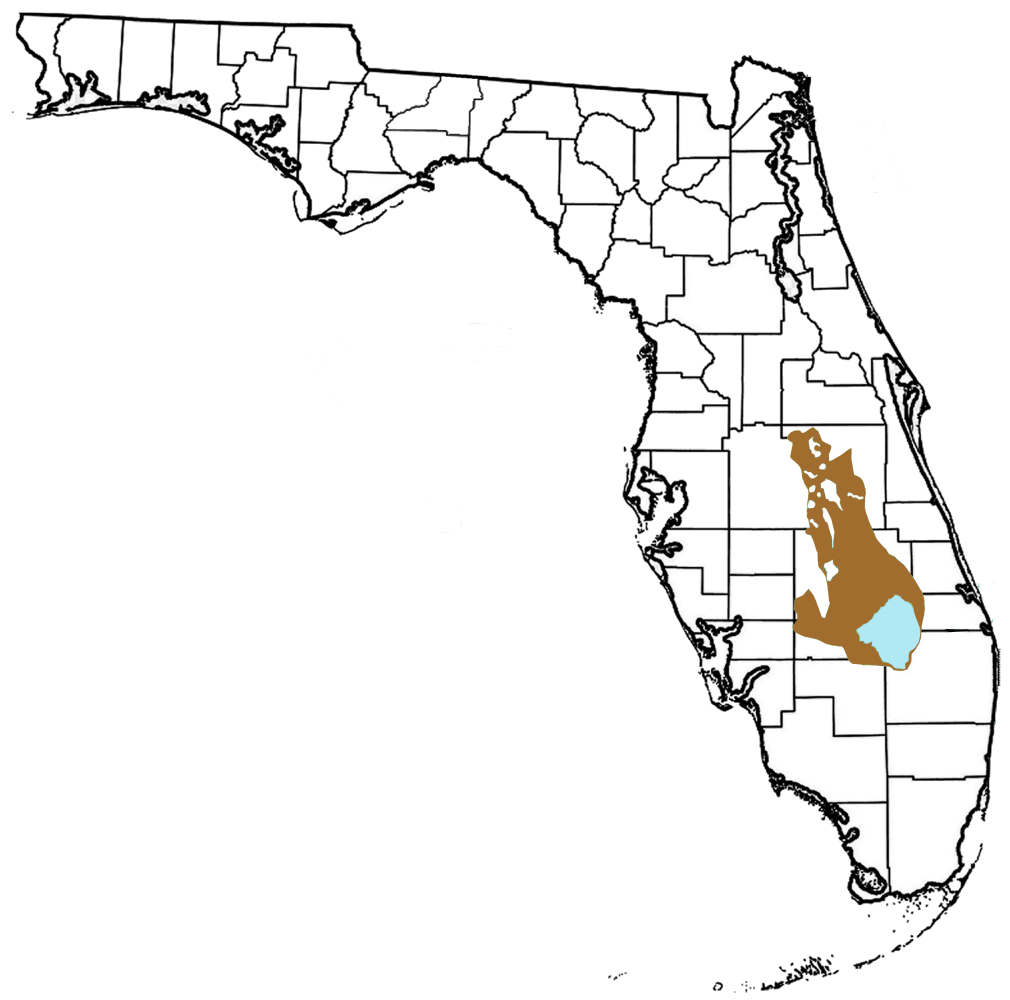|
Okeechobee Plain
The Okeechobee Plain is a major geologic feature of Florida formed during the Pliocene and Pleistocene epochs and named for Okeechobee County, Florida, United States. Description The Okeechobee Plain is a dry prairie or grassland located directly north of Lake Okeechobee and is present in the counties of Highlands (eastern), Glades (northeastern), Indian River (western) and Okeechobee where it is present along the western bank of the Kissimmee River. The Okeechobee Plain is within the Kissimmee/Okeechobee Lowland established by the Florida Department of Environmental Protection's Lake Bioassessment/Regionalization Initiative. Origin The Okeechobee Plain was created during the Pliocene and Pleistocene's wild climatic times through continuous depositing of sediments from rivers as the peninsula grew southward. During the Piacenzian (3.6—2.5 Ma) stage of the Pliocene the plain, was, for the most part, submerged and is referred to as part of the Kissimmee Embayment.Petuch, Edw ... [...More Info...] [...Related Items...] OR: [Wikipedia] [Google] [Baidu] |
Okeechobee Plain Location Map
Okeechobee may refer to: *Lake Okeechobee, in Florida, United States *Okeechobee, Florida, United States *Okeechobee County, Florida, United States *Okeechobee Waterway, in Florida, United States *Okeechobee Plain, in Florida, United States *Okeechobee Group, geologic group in Florida, United States *Okeechobee (Metrorail station) *Okeechobee (Amtrak station) *1928 Okeechobee hurricane *Okeechobee Music & Arts Festival, in Florida, United States {{disambig, geo ... [...More Info...] [...Related Items...] OR: [Wikipedia] [Google] [Baidu] |
Kissimmee River
The Kissimmee River is a river in south-central Florida, United States that forms the north part of the Everglades wetlands area. The river begins at East Lake Tohopekaliga south of Orlando, flowing south through Lake Kissimmee into the large, shallow Lake Okeechobee. Hurricane-related floods in 1947 prompted channelization of the meandering lower stretch, completed by 1970. The straightened course reduced wetland habitat and worsened pollution. In response, ongoing efforts since the 1990s have partially restored the river's original state and revitalized the ecosystem (see Restoration of the Everglades). Course The Kissimmee River arises in Osceola County as the outflow from East Lake Tohopekaliga, passing through Lake Tohopekaliga, Lake Cypress, Lake Hatchineha and Lake Kissimmee. Below Lake Kissimmee, the river forms the boundary between Osceola County and Polk County, between Highlands County and Okeechobee County, and between Glades County and Okeechobee County before ... [...More Info...] [...Related Items...] OR: [Wikipedia] [Google] [Baidu] |
Caloosahatchee Incline
Caloosahatchee may refer to: * Caloosahatchee River, a river on the southwest Gulf Coast of Florida in the United States * Caloosahatchee culture, an archaeological culture on the Gulf coast of Southwest Florida that lasted from about 500 to 1750 CE * Caloosahatchee National Wildlife Refuge, part of the United States National Wildlife Refuge System * USS Caloosahatchee (AO-98), US Navy ship {{disambig ... [...More Info...] [...Related Items...] OR: [Wikipedia] [Google] [Baidu] |
Osceola Plain
Osceola (1804 – January 30, 1838, Asi-yahola in Creek), named Billy Powell at birth in Alabama, became an influential leader of the Seminole people in Florida. His mother was Muscogee, and his great-grandfather was a Scotsman, James McQueen. He was reared by his mother in the Creek (Muscogee) tradition. When he was a child, they migrated to Florida with other Red Stick refugees, led by a relative, Peter McQueen, after their group's defeat in 1814 in the Creek Wars. There they became part of what was known as the Seminole people. In 1836, Osceola led a small group of warriors in the Seminole resistance during the Second Seminole War, when the United States tried to remove the tribe from their lands in Florida to Indian Territory west of the Mississippi River. He became an adviser to Micanopy, the principal chief of the Seminole from 1825 to 1849. [...More Info...] [...Related Items...] OR: [Wikipedia] [Google] [Baidu] |
Kissimmee Embayment
Kissimmee ( ) is the largest city and county seat of Osceola County, Florida, United States. As of the 2020 census, the population was 79,226. It is a Principal City of the Orlando-Kissimmee-Sanford, Florida, Metropolitan Statistical Area, which had a 2010 population of 2,234,411. History This area was originally named Allendale, after Confederate Major J. H. Allen who operated the first cargo steamboat along the Kissimmee River—the ''Mary Belle''. It was renamed Kissimmee when incorporated as a city in 1883. The modern town, which is the county seat of Osceola County, was founded before the Civil War by the Bass, Johnson and Overstreet families. The etymology of the name Kissimmee is debated, apart from general agreement that it is Native American in origin. Its growth can be credited to Hamilton Disston of Philadelphia, who based his four-million acre (8,000 km2) drainage operation out of the small town. Disston had contracted with the financially wobbly state of ... [...More Info...] [...Related Items...] OR: [Wikipedia] [Google] [Baidu] |
Piacenzian
The Piacenzian is in the international geologic time scale the upper stage or latest age of the Pliocene. It spans the time between 3.6 ± 0.005 Ma and 2.588 ± 0.005 Ma (million years ago). The Piacenzian is after the Zanclean and is followed by the Gelasian (part of the Pleistocene). The Piacenzian is roughly coeval with the European land mammal age MN 16, overlaps the late Chapadmalalan and early Uquian South American land mammal age and falls inside the more extensive Blancan North American land mammal age. It also correlates with the Astian, Redonian, Reuverian and Romanian regional stages of Europe. Some authorities describe the British Red Crag Formation and Waltonian Stage as late Piacenzian, while others regard them as early Pleistocene. Carbon dioxide levels during the Piacenzian were similar to those of today, making this age, with global mean temperature 2–3 °C higher and sea levels about twenty meters higher than today, an important analogue for predictions of the ... [...More Info...] [...Related Items...] OR: [Wikipedia] [Google] [Baidu] |
Peninsula
A peninsula (; ) is a landform that extends from a mainland and is surrounded by water on most, but not all of its borders. A peninsula is also sometimes defined as a piece of land bordered by water on three of its sides. Peninsulas exist on all continents. The size of a peninsula can range from tiny to very large. The largest peninsula in the world is the Arabian Peninsula. Peninsulas form due to a variety of causes. Etymology Peninsula derives , which is translated as 'peninsula'. itself was derived , or together, 'almost an island'. The word entered English in the 16th century. Definitions A peninsula is usually defined as a piece of land surrounded on most, but not all sides, but is sometimes instead defined as a piece of land bordered by water on three of its sides. A peninsula may be bordered by more than one body of water, and the body of water does not have to be an ocean or a sea. A piece of land on a very tight river bend or one between two rivers is sometimes ... [...More Info...] [...Related Items...] OR: [Wikipedia] [Google] [Baidu] |
Sediment
Sediment is a naturally occurring material that is broken down by processes of weathering and erosion, and is subsequently transported by the action of wind, water, or ice or by the force of gravity acting on the particles. For example, sand and silt can be carried in suspension in river water and on reaching the sea bed deposited by sedimentation; if buried, they may eventually become sandstone and siltstone (sedimentary rocks) through lithification. Sediments are most often transported by water ( fluvial processes), but also wind ( aeolian processes) and glaciers. Beach sands and river channel deposits are examples of fluvial transport and deposition, though sediment also often settles out of slow-moving or standing water in lakes and oceans. Desert sand dunes and loess are examples of aeolian transport and deposition. Glacial moraine deposits and till are ice-transported sediments. Classification Sediment can be classified based on its grain size, grain sh ... [...More Info...] [...Related Items...] OR: [Wikipedia] [Google] [Baidu] |
Kissimmee/Okeechobee Lowland
The Kissimmee/Okeechobee Lowland is one of 47 distinct lake regions within the state of Florida, United States. Location The Kissimmee/Okeechobee is located in the central part of the state bounding Lake Okeechobee to the south and extending north to the Osceola Slope in Osceola County. It is bounded on the west by the Lake Wales Ridge and on the east by the Eastern Flatlands. Counties within its borders are Osceola, Highlands, Polk, Okeechobee, and Glades. Origin The Kissimmee/Okeechobee Lowland's name was established by Florida Department of Environmental Protection's Lake Bioassessment/Regionalization Initiative. Delineations are determined by soils, physiography, geology, hydrology, vegetation, climate, and land use. It has the United States Environmental Protection Agency ecoregion designation of 75–35. Its physical origin is Pleistocene though it sits atop earlier deposits of sediments. Its southern end is the ancient Kissimmee Embayment of the Pliocene. It's interg ... [...More Info...] [...Related Items...] OR: [Wikipedia] [Google] [Baidu] |
Indian River County, Florida
Indian River County ( es, Condado de Río Indio, link=) is a county located in the Treasure Coast region of the U.S. state of Florida. As of the 2020 census, the population was 159,788. Its seat is Vero Beach. It is Florida's 7th richest county and in 2000 was the 87th richest county in the U.S. by per capita income. Indian River County comprises the Sebastian-Vero Beach, Florida, Metropolitan Statistical Area, which is included in the Miami-Fort Lauderdale-Port St. Lucie, Florida, Combined Statistical Area. History Prior to 1821 the area of Indian River County was part of the Spanish colony of East Florida. In 1822 this area became part of St. Johns County, and in 1824 it became part of Mosquito County (original name of Orange County). The Second Seminole War was fought in 1835 and from 1838 to 1839. Fort Vinton was built for this purpose near the intersection of present-day Florida State Road 60 and 122nd Avenue. In 1844 the county's portion of Mosquito County became part ... [...More Info...] [...Related Items...] OR: [Wikipedia] [Google] [Baidu] |
Pliocene
The Pliocene ( ; also Pleiocene) is the epoch in the geologic time scale that extends from 5.333 million to 2.58See the 2014 version of the ICS geologic time scale million years ago. It is the second and most recent epoch of the Period in the Cenozoic Era. The Pliocene follows the Miocene Epoch and is followed by the Pleistocene Epoch. Prior to the 2009 revision of the geologic time scale, which placed the fou ... [...More Info...] [...Related Items...] OR: [Wikipedia] [Google] [Baidu] |
Glades County, Florida
Glades County is a county located in the Florida Heartland region of the U.S. state of Florida. As of the 2020 census, the population was 12,126, making it the fourth-least populous county in Florida. Its county seat is Moore Haven. Awards * Gov. Jeb Bush acknowledged Muse winning the Florida's Outstanding Rural Community of the Year 2002 award after "providing a safe community shelter to be used during storms." * Senior Ranger Danny Callahan, of the Florida Forest Service presented Jimmy Cianfrani and the Muse Community with a "10 Year Firewise Service Award" for "its diligence and commitment to the National Firewise Communities USA program. From the smallest project of cleaning the debris off their roofs to the largest undertaking of clearing flammable vegetation 30 feet away from their houses, the Muse Community’s dedication to reducing wildfire risk is commendable." History Indigenous people lived in this area for thousands of years. Due to warfare and exposure to in ... [...More Info...] [...Related Items...] OR: [Wikipedia] [Google] [Baidu] |





